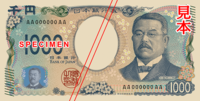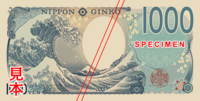| (Japan) | |
|---|---|
| Value | 1,000 Yen |
| Width | 150 mm |
| Height | 76 mm |
| Security features | Fluorescent ink, intaglio printing, latent imaging, luminescent ink, microprinting, pearl ink, tactile marks, watermark, watermark-bar pattern, EURion constellation[1] |
| Years of printing | 1950, 1963 (black serial numbers), 1976 (blue serial numbers), 1984 (black serial numbers), 1990 (blue serial numbers), 1993 (brown serial numbers), 2000 (green serial numbers), 2004 (black serial numbers), 2011 (brown serial numbers), 2019 (blue serial numbers), 2024 |
| Obverse | |
 | |
| Design | portrait of Kitasato Shibasaburō |
| Reverse | |
 | |
| Design | The Great Wave off Kanagawa |
The ¥1,000 note is currently the lowest value yen banknote and has been used since 1945, excluding a brief period between 1946 and 1950 during the Allied occupation of Japan.
The sixth series (series F) notes are currently in circulation, and are the smallest of the three common bank notes. Extensive anti-counterfeiting measures are present in the newest banknotes. While the older notes are no longer issued, they continue to be legal tender.[2]
- ^ "Security features of the new 1,000 yen note". Bank of Japan. Retrieved 14 August 2014.
- ^ "Banknotes in Use but No Longer Issued". National Printing Bureau. Retrieved 2 September 2019.